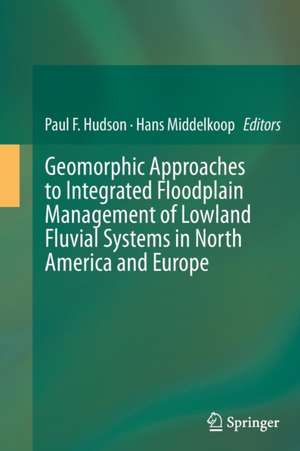Geomorphic Approaches to Integrated Floodplain Management of Lowland Fluvial Systems in North America and Europe
Editat de Paul F. Hudson, Hans Middelkoopen Limba Engleză Paperback – 13 oct 2016
Recognition of the failure of old perspectives on river management and the need to enhance environmental sustainability has stimulated a new approach to river management. The manner that river restoration and integrated management are implemented, however, requires a case study approach that takes into account the impact of historic human impacts to the system, especially engineering. The river basins examined in this volume provide a representative coverage of the drainage of North America and Europe, taking into account a range of climatic and physiographic provinces. They include the 1) Sacramento (California, USA), 2) San Joaquin (California), 3) Missouri (Missouri, USA), 4) Red (Manitoba, Canada and Minnesota, USA), 5) Mississippi (Louisiana, USA), 6) Kissimmee (Florida, USA), 7) Ebro (Spain), 8) Rhone (France), 9) Rhine (Netherlands), 10) Danube (Romania), and 11) Volga (Russian Federation) Rivers. The case studies covered in these chapters span a range of fluvial modes of adjustment, including sediment, channel, hydrologic regime, floodplains, as well as ecosystem and environmental associations.
| Toate formatele și edițiile | Preț | Express |
|---|---|---|
| Paperback (1) | 643.84 lei 6-8 săpt. | |
| Springer – 13 oct 2016 | 643.84 lei 6-8 săpt. | |
| Hardback (1) | 650.19 lei 6-8 săpt. | |
| Springer – 30 apr 2015 | 650.19 lei 6-8 săpt. |
Preț: 643.84 lei
Preț vechi: 757.46 lei
-15% Nou
Puncte Express: 966
Preț estimativ în valută:
123.20€ • 131.74$ • 102.72£
123.20€ • 131.74$ • 102.72£
Carte tipărită la comandă
Livrare economică 17 aprilie-01 mai
Preluare comenzi: 021 569.72.76
Specificații
ISBN-13: 9781493942435
ISBN-10: 1493942433
Pagini: 356
Ilustrații: IX, 356 p. 132 illus., 78 illus. in color.
Dimensiuni: 155 x 235 x 19 mm
Greutate: 0.51 kg
Ediția:Softcover reprint of the original 1st ed. 2015
Editura: Springer
Colecția Springer
Locul publicării:New York, NY, United States
ISBN-10: 1493942433
Pagini: 356
Ilustrații: IX, 356 p. 132 illus., 78 illus. in color.
Dimensiuni: 155 x 235 x 19 mm
Greutate: 0.51 kg
Ediția:Softcover reprint of the original 1st ed. 2015
Editura: Springer
Colecția Springer
Locul publicării:New York, NY, United States
Cuprins
1. Introduction.- 2. Sand and gravel on the move: Human impacts on bed-material load along the lower Rhine River.- 3. Channel responses to global change and local impacts: perspectives and tools for floodplain management.- 4. Impact scales of fluvial response to management along the Sacramento River, California, USA: Transience versus persistence.- 5. Flooding, structural flood control measures, and a geomorphic context for the flood problem along the Red River, Manitoba, Canada.- 6. Flooding, structural flood control measures, and a geomorphic context for the flood problem along the Red River, Manitoba, Canada.- 7. Geomorphic Perspectives of Managing, Modifying and Restoring a River with Prolonged Flooding: Kissimmee River, Florida, USA.- 8. Managing the Mississippi River Floodplain: Achieving ecological benefits requires more than hydrological connection to the river.- 9. The role of floodplain restoration in mitigating flood risk, Lower Missouri River, USA.- 10. Post-dam channel and floodplain adjustment to the Lower Volga River, Russia.- 11. Embanking the Lower Danube: from natural to engineered floodplains and back.- 12. Historical Development and Integrated Management of the Rhône River Floodplain, from the Alps to the Camargue Delta, France.- 13. The Role of Floodplain Geomorphology in Policy and Management Decisions along the Lower Mississippi River in Louisiana.- 14. The palimpsest of river-floodplain management and the role of geomorphology.
Notă biografică
Paul Hudson is Associate Professor of Physical Geography at Leiden University, The Netherlands. After completing a PhD in fluvial geomorphology at Louisiana State University, Hudson was Assistant and then Associate Professor at the University of Texas at Austin for fourteen years, until his move to The Netherlands. His current projects examine river management and geomorphology along rivers in Northern Europe, Texas, and the Lower Mississippi River in Louisiana.
Hans Middelkoop is full professor of Physical Geography at Utrecht University. After completing his PhD on embanked floodplains at Utrecht University, Middelkoop was employed at the Netherlands’ national Institute for Inland Water Management and Wastewater Treatment (RWS-RIZA). Since 1999 Middelkoop has been appointed at Utrecht University. His research group examines the morphodynamics of rivers, floodplains and deltas across a range of scales, and how these change in response to internal fluvial dynamics, climate, land use changes and human impact. Middelkoop has been active in numerous research projects related to river restoration.
Hans Middelkoop is full professor of Physical Geography at Utrecht University. After completing his PhD on embanked floodplains at Utrecht University, Middelkoop was employed at the Netherlands’ national Institute for Inland Water Management and Wastewater Treatment (RWS-RIZA). Since 1999 Middelkoop has been appointed at Utrecht University. His research group examines the morphodynamics of rivers, floodplains and deltas across a range of scales, and how these change in response to internal fluvial dynamics, climate, land use changes and human impact. Middelkoop has been active in numerous research projects related to river restoration.
Textul de pe ultima copertă
This volume provides a comprehensive perspective on geomorphic approaches to management of lowland alluvial rivers in North America and Europe. Many lowland rivers have been heavily managed for flood control and navigation for decades or centuries, resulting in engineered channels and embanked floodplains with substantially altered sediment loads and geomorphic processes. Over the past decade, floodplain management of many lowland rivers has taken on new importance because of concerns about the potential for global environmental change to alter floodplain processes, necessitating revised management strategies that minimize flood risk while enhancing environmental attributes of floodplains influenced by local embankments and upstream dams.
Recognition of the failure of old perspectives on river management and the need to enhance environmental sustainability has stimulated a new approach to river management. The manner that river restoration and integrated management are implemented, however, requires a case study approach that takes into account the impact of historic human impacts to the system, especially engineering. The river basins examined in this volume provide a representative coverage of the drainage of North America and Europe, taking into account a range of climatic and physiographic provinces. They include the 1) Sacramento (California, USA), 2) San Joaquin (California), 3) Missouri (Missouri, USA), 4) Red (Manitoba, Canada and Minnesota, USA), 5) Mississippi (Louisiana, USA), 6) Kissimmee (Florida, USA), 7) Ebro (Spain), 8) Rhone (France), 9) Rhine (Netherlands), 10) Danube (Romania), and 11) Volga (Russian Federation) Rivers. The case studies covered in these chapters span a range of fluvial modes of adjustment, including sediment, channel, hydrologic regime, floodplains, as well as ecosystem and environmental associations.
Recognition of the failure of old perspectives on river management and the need to enhance environmental sustainability has stimulated a new approach to river management. The manner that river restoration and integrated management are implemented, however, requires a case study approach that takes into account the impact of historic human impacts to the system, especially engineering. The river basins examined in this volume provide a representative coverage of the drainage of North America and Europe, taking into account a range of climatic and physiographic provinces. They include the 1) Sacramento (California, USA), 2) San Joaquin (California), 3) Missouri (Missouri, USA), 4) Red (Manitoba, Canada and Minnesota, USA), 5) Mississippi (Louisiana, USA), 6) Kissimmee (Florida, USA), 7) Ebro (Spain), 8) Rhone (France), 9) Rhine (Netherlands), 10) Danube (Romania), and 11) Volga (Russian Federation) Rivers. The case studies covered in these chapters span a range of fluvial modes of adjustment, including sediment, channel, hydrologic regime, floodplains, as well as ecosystem and environmental associations.
Caracteristici
Provides a comprehensive perspective on geomorphic approaches to floodplain management Identifies problems and provides a synthesis and review of environmental change issues confronting floodplain management Targets the links between river channel dynamics and floodplain geomorphology Includes supplementary material: sn.pub/extras


























